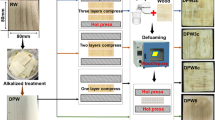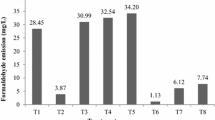Abstract
Jabon wood (Anthocephalus cadamba Miq.) and coconut fibres currently appear to be the most viable raw material alternative in wood-based industries. This study examines the hybrid composites incorporating the Jabon trunk veneer and coconut fibres in a plywood product and analyses its properties. The samples were arranged into five-ply hybrid plywoods based on coconut fibre arrangements, comprising coconut woven fibre mats (HPWF) and coconut non-woven fibre mats (HPRF). Hybrid plywood with a thickness of 14 mm was cold pressed and hot pressed using urea formaldehyde (UF) and phenol formaldehyde (PF) resin, respectively. The dimensional stability and mechanical properties of the Jabon plywood and hybrid plywood composites were analysed. The hybridisation of coconut fibres with the Jabon trunk improved the dimensional stability and mechanical properties of plywood, such as its density, thickness swelling, bending, and screw withdrawal, especially for hybrid plywood using PF. Similarly, HPRF also demonstrated an increase in dimensional stability and mechanical properties. The weak bonding interface between the coconut fibre and formaldehyde matrix caused fibre-pull-out to happen in the hybrid plywood composite. The HPRF had better properties than HPWF. Statistical analyses show that coconut fibre arrangement of woven mats, and non-woven mats, and types of adhesive of UF, and PF did affect dimensional stability and mechanical properties, even though the interaction between the two did not affect density.









Similar content being viewed by others
References
Abdul Khalil HPS, Hanida S, Kang CE, Nik Fuaad NA (2007) Agro-hybrid composite: The effects on mechanical and physical properties of oil palm fiber (EFB)/glass hybrid reinforced polyester composites. J Reinf Plast Compos 26(2):203–218. https://doi.org/10.1177/0731684407070027
Abdul Khalil HPS, Fazita N, Bhat AH, Nik Fuad NA (2010) Development and material properties of new hybrid plywood from oil palm biomass. Mater Design 31(1):417–424. https://doi.org/10.1016/j.matdes.2009.05.040
Abdul Khalil HPS, Sri Aprilia NA, Bhat AH, Jawaid M, Paridah MT, Dungani R (2013) A jatropha as renewable materials for biocomposites and its applications. Renew Sust Energ Rev 22:667–686. https://doi.org/10.1016/j.rser.2012.12.036
Alamsyah EM, Yamada M, Taki K (2008) Bondability of tropical fast-growing tree species III: Curing behavior of resorcinol formaldehyde resin adhesive at room temperature and effects of extractives of Acacia mangium wood on bonding. J Wood Sci 54(3):208–213. https://doi.org/10.1007/s10086-007-0945-1
Arsène MA, Bilba K, Junior HS, Ghavami K (2013) Treatments of non-wood plant fibres used as reinforcement in composite materials. Mater Res 16(4):903–923. https://doi.org/10.1590/S1516-14392013005000084
Arsyad M, Wardana NG, Pratikto Irawan YS (2015) The morphology of coconut fiber surface under chemical treatment”. Matéria 20(1):169–177. https://doi.org/10.1590/S1517-707620150001.0017
Aydin I (2004) Activation of wood surfaces for glue bonds by mechanical pretreatment and its effects on some properties of veneer surfaces and plywood panels. Appl Surf Sci 233(1):268–274. https://doi.org/10.1016/j.apsusc.2004.03.230
Aydin I, Colakoglu G (2005) Formaldehyde emission, surface roughness, and some properties of plywood as function of veneer drying temperature. Dry Technol 23(5):1107–1117. https://doi.org/10.1081/DRT-200059142
Ayrilmis N, Jarusombuti S, Fueangvivat V, Bauchongkol P, White RH (2011) Coir fiber reinforced polypropylene composite panel for automotive interior applications. Fiber Polym 12:919–926. https://doi.org/10.1007/s12221-011-0919-1
Bekhta P, Ortynska G, Sedliacik J (2014) Properties of modified phenol-formaldehyde adhesive for plywood panels manufactured from high moisture content veneer. Drv Ind 65(4):293–301. https://doi.org/10.5552/drind.2014.1350
Bhat IH, Abdul Khalil HPS, Nurul Fazita MR, Abdullah CK (2011) Hybridized biocomposites from agro-wastes: mechanical, physical and thermal characterization. J Polym Environ 19(1):49–58. https://doi.org/10.1007/s10924-010-0245-5
BS EN 320 (1993) Fibreboards—determination of resistance to axial withdrawal of screws (Withdrawn). British Standards Institution
BS EN 310 (1993) Wood-based panels. Determination of modulus of elasticity in bending and of bending strength. British Standards Institution, UK
BS EN 317 (1993) Standard test methods for Particleboards and fibreboards. Determination of swelling in thickness after immersion in water. British Standards Institution, UK
BS EN 322 (1993) Wood-based panels. Determination of moisture content. British Standards Institution, UK
BS EN 323 (1993) Standard test methods for Wood-based panels. Determination of density. British Standards Institution, UK
Bujang IZ, Awang MK, Ismail AE (2007) Study on the dynamic characteristic of coconut fibre reinforced composites. In: Regional conference on engineering mathematics, mechanics, manufacturing and architecture 2007, Kuala Lumpur, 27–28 Nov 2007
Celebi G, Kilic M (2007) Nail and screw withdrawal strength of laminated veneer lumber made up hardwood and softwood layers. Constr Build Mater 21(4):894–900. https://doi.org/10.1016/j.conbuildmat.2005.12.015
Chai LY, H’ng PS, Lim CG, Chin KL, Jusoh MZ, Bakar ES (2011) Production of oil palm trunk core board with wood veneer lamination. J Oil Palm Res 23:1166–1171
Chandra Rao CH, Madhusudan S, Raghavendra G, Venkateswara Rao E (2012) Investigation into wear behavior of coir fiber reinforced epoxy composites with the Taguchi method. J Eng Res Appl 5:347–371
Dinwoodie JM (1978) The properties and performance of particle board adhesives. J Inst Wood Sci 8:59–68. https://trove.nla.gov.au/version/33501687
Dungani R, Karina M, Subyakto Sulaeman A, Hermawan D, Hadiyane A (2016) Agricultural waste fibers towards sustainability and advanced utilization: a review. Asian J Plant Sci 15(1–2):42–55. https://doi.org/10.3923/ajps.2016.42.55
Ede AN, Agbede JO (2015) Use of coconut husk fiber for improved compressive and flexural strength of concrete. Int J Sci Eng Res 6(2):968–974
Feng LY, Tahir P, Hoong YB (2011) Density distribution of oil palm stem veneer and its influence on plywood mechanical properties. J Appl Sci 11(5):824–831. https://doi.org/10.3923/jas.2011.824.831
Ganeshram V, Achudhan M (2013) Synthesis and characterization of phenol formaldehyde resin as a binder used for coated abrasives. Indian J Sci Technol 6(6S):4814–4823
Girisha C, Sanjeevamurthy Srinivas GR (2012) Sisal/coconut coir natural fibers-epoxy composites: water absorption and mechanical properties. Int J Innov Technol Explor Eng 2(3):166–170
Hadi YS, Rahayu IS, Danu S (2013) Physical and mechanical properties of methyl methacrylate impregnated jabon wood. J Indian Acad Wood Sci 10(2):77–80. https://doi.org/10.1007/s13196-013-0098-3
Harish S, Michael DP, Bensely A, Mohan Lal D, Rajadurai A (2009) Mechanical property evaluation of natural fiber coir composite. Mater Char 60(1):44–49. https://doi.org/10.1016/j.matchar.2008.07.001
Hasan NS, Sobuz HR, Sayed S, Islam S (2012) The use of coconut fibre in the production of structural lightweight concrete. J Appl Sci 12(9):831–839. https://doi.org/10.3923/jas.2012.831.839
Irawan US, Purwanto E (2014) White jabon (Anthocephalus cadamba) and red jabon (Anthocephalus macrophyllus) for community land rehabilitation: improving local propagation efforts. Agri Sci 2(3):36–45. https://doi.org/10.12735/as.v2i3p36
Khairiah B, Mat Amin KA (2006) Biocomposites from oil palm resources. J Oil Palm Res Special Issue 103–113
Lempang M (2014) Basic properties and potential uses of Jabon merah wood. Jurnal Penelitian Kehutanan Wallacea 3(2):163–175. https://doi.org/10.18330/jwallacea.2014
Misra RK, Kumar S, Sandeep K, Misra A (2007) Some experimental and theoretical investigations on fire retardant coir/epoxy micro-composites. J Thermoplas Compos Mater 21(1):1–32. https://doi.org/10.1177/0892705707084544
Namvar FM, Jawaid M, Tanir PP, Mohamad R, Azizi S, Khodavandi A, Rahman AS, Nayeri MD (2014) Potential use of plant fibres and their composites for biomedical applications. BioResources 9(3):5688–5706
Okino EYA, Teixeira DE, de Souza MR, Santana MAE, de Sousa ME (2004) Properties of oriented strandboard made of wood species from Brazilian planted forests: Part 1: 80 mm-long strands of Pinus taeda L. Holz Roh Werkst 62(3):221–224. https://doi.org/10.1007/s00107-004-0472-3
Ozcifci A, Okcu O (2008) The influence of the impregnating chemicals on the bonding strength of impregnated wood materials. J Appl Polym Sci 107(5):2871–2876. https://doi.org/10.1002/app.27370
Pan M, Zhou X, Chen M (2013) Cellulose nanowhiskers isolation and properties from acid hydrolysis combined with high pressure homogenization. BioResources 8(1):933–943
Praksh RB, Satish S, Thomasrenald CJ (2014) Investigation on tensile and flexural properties of coir fiber reinforced isophthalic polyester composites. Int J Curr Sci Technol 39:220–225. https://doi.org/10.14741/ijcet/spl.2.2014.39
Qiao Z, Gu J, Zuo Y, Tan H, Zhang Y (2014) The effect of carboxymethyl cellulose addition on the properties of starch-based wood adhesive. BioResources 9(4):6117–6129
Rahaman MM, Akhter K, Biswas D, Sheikh MW (2012) Suitability of hybrid acacia wood for manufacturing plywood and particleboard. J Bangla Acad Sci 36(2):171–176. https://doi.org/10.3329/jbas.v36i2.12960
Rajini N, Winowlin Jappes JT, Jeyaraj P, Rajakarunakaran S, Bennet C (2013) Effect of montmorillonite nanoclay on temperature dependence mechanical properties of naturally woven coconut sheath/polyester composite. J Reinf Plast Comp 32(11):811–822. https://doi.org/10.1177/0731684413475721
Reddy N, Yang Y (2005) Biofibers from agricultural by products for industrial applications. Trends Biotechnol 23(1):22–27. https://doi.org/10.1016/j.tibtech.2004.11.002
Rimdusit S, Damrongsakkul S, Wongmanit P, Saramas D, Tiptipakorn S (2011) Characterization of coconut fiber-filled polyvinyl chloride/acrylonitrile styrene acrylate blends. J Reinf Plast Comp 30(20):1691–1702. https://doi.org/10.1177/0731684411427484
Romli FI, Alias AN, Rafie ASM, Majid DLAA (2012) Factorial study on the tensile strength of a coir fiber-reinforced epoxy composite. AASRI Procedia 3:242–247. https://doi.org/10.1016/j.aasri.2012.11.040
Rosamah E, Hossain S, Abdul Khalil HPS, Wan Nadirah WO, Dungani R, Nur Amiranajwa AS, Suraya LNM, Fizree HM, Mohd Omar AK (2016) Properties enhancement using oil palm shell nanoparticles of fibers reinforced polyester hybrid composites. Adv Compos Mater 26(3):259–272. https://doi.org/10.1080/09243046.2016.1145875
Sakthivel M, Ramesh S (2013) Mechanical properties of natural fiber (banana, coir, sisal) polymer composites. Sci Park 1(1):1–6
Semple KE, Smith GD (2006) Prediction of internal bond strength in particleboard from screw withdrawal resistance models. Wood Fiber Sci 38(2):256–267
Sreekala MS, Kumaran MG, Thomas S (2002) Water sorption in oil palm fiber reinforced phenol formaldehyde composites. Compos Part A Appl Sci Manuf 33(6):763–777. https://doi.org/10.1016/S1359-835X(02)00032-5
Suhara P, Mohini S (2007) Studies on the water absorption properties of short hemp–glass fiber hybrid polypropylene composites. J Compos Mater 41:1871–1883. https://doi.org/10.1177/0021998307069900
Sulaiman O, Salim N, Hashim R, Yusof LHM, Razak W, Yunus NYM, Hashim WS, Azmy MH (2007) Evaluation on the suitability of some adhesives for laminated veneer lumber from oil palm trunks. Mater Design 30(9):3572–3580. https://doi.org/10.1016/j.matdes.2009.02.027
Tonge LY, Hodgkin J, Blicblau AS, Collins PJ (2001) Effects of initial phenol-formaldehyde (PF) reaction products on the curing Properties of PF resin. J Therm Anal Calorim 64(2):721–730. https://doi.org/10.1023/A:1011544411747
Wang S, Zhang Y, Xing C (2007) Effect of drying method on the surface wettability of wood strands. Holz Roh Werkst 65(6):437–442. https://doi.org/10.1007/s00107-007-0191-7
Widiyanto A, Siarudin M (2016) Characteristics of physical properties of jabon wood (Anthocephalus cadamba Miq) on longitudinal and radial section. J Hutan Tropis 4(2):41–45
Yao J, Hu Y, Lu W (2012) A wood replacement material of sandwich structure using coir fiber mat and fiberglass fabrics as core layer. BioResources 5(1):663–674
Zaman HU, Beg MDH (2014) Preparation, structure and properties of the coir fiber/polypropylene composites. J Compos Mater 48(26):3293–3301. https://doi.org/10.1177/0021998313508996
Acknowledgements
The authors would like to thank Institut Teknologi Bandung (ITB), for providing Research Grants of Research, Community Services and Innovation Program (P3MI)-ITB (1267/RU-ITB/2018). The authors would also like to thank Laboratory of wood basic properties, School of Life Sciences and Technology, Institut Teknologi Bandung, Indonesia, for providing the necessary facilities for testing.
Author information
Authors and Affiliations
Corresponding author
Additional information
Publisher's Note
Springer Nature remains neutral with regard to jurisdictional claims in published maps and institutional affiliations.
Rights and permissions
About this article
Cite this article
Dungani, R., Karliati, T., Hadiyane, A. et al. Coconut fibres and laminates with Jabon trunk (Anthocephalus cadamba Miq.) veneer for hybrid plywood composites: dimensional stability and mechanical properties. Eur. J. Wood Prod. 77, 749–759 (2019). https://doi.org/10.1007/s00107-019-01432-9
Received:
Published:
Issue Date:
DOI: https://doi.org/10.1007/s00107-019-01432-9




